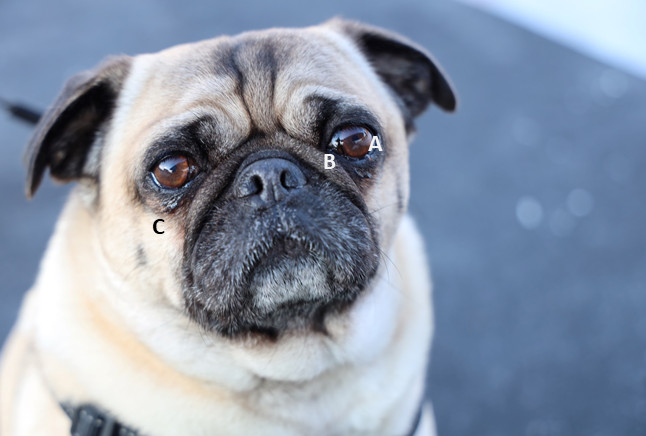Animals with exaggerated physical features, like brachycephalic or flat-faced dogs and cats, have loving personalities and form strong bonds with their owners. However, there are health and welfare problems associated with their conformation due to selective breeding.
Brachycephalic breeds with flattened faces commonly have eye sockets that are very shallow. Their ‘pop eyed’ appearance may lead to various abnormalities of the eye and related diseases due to having shallow eye sockets, which are known collectively as Brachycephalic Ocular Syndrome [1–2]. Breeds such as Pugs, British Bulldogs, and French Bulldogs are predisposed to Brachycephalic Ocular Syndrome [3].
Abnormalities seen in animals with Brachycephalic Ocular Syndrome may include [1–2]:
- Eye trauma and ulceration
- Abnormal protrusion of the eyes (the characteristic ‘pop eyed’ appearance)
- Excessively widened eyelids
- Inability to completely close eyelids
- Folding of the facial skin and entropion (an abnormality where the eyelids fold inwards and scratch the eyeball)
- Abnormal tear production, which can be excessive (leading to overflowing tears) or reduced and of poorer quality (which can lead to dry eyes).
These problems occur because of selective breeding for extreme facial features such as a very flat face, very wrinkly facial skin and very large bulging eyes, in order to conform to the breed standard.

The abnormally large and protruding eyes of dogs with Brachycephalic Ocular Syndrome mean that their eyelids cannot close properly over their eyeballs. This dries their eyes and often leads to eye ulcers. This results in pain and potential blindness. Sometimes the affected eye needs to be surgically removed.
The flatter the face, the shallower the eye socket and the more prominent the eye. Prominent, bulging eyes are at greater risk of injury and sometimes they actually pop out of their socket, causing severe pain and requiring emergency treatment.
To help prevent these conditions and minimise pain and discomfort, these dogs may need to undergo multiple surgeries, although some of the conformational conditions cannot be fully corrected by surgery [4]. Frequent or life-long topical eye medications may be needed [4]. Also, blindness can occur long term or if left untreated.
More information
RSPCA Australia and the AVA are raising awareness to try to change how purebred dogs are selected and bred in Australia. Current and potential owners can play a vital role in helping to improve the welfare and lives of brachycephalic breeds. For more information or to get involved, visit the following websites: Love is Blind, Australian Veterinary Association. See also: American College of Veterinary Surgeons, International Cat Care, Universities Federation for Animal Welfare and UPEI Canine Inherited Disorders Database.
References
[1] Universities Federation for Animal Welfare (2011) Brachycephalic Ocular Syndrome in Pugs (accessed on June 23, 2021).
[2] Plummer CE (2015) Addressing brachycephalic ocular syndrome in the dog. Today’s Vet Practice 5: 20-25.
[3] Costa J et al (2021) Clinical signs of brachycephalic ocular syndrome in 93 dogs. Irish Veterinary Journal 74(1): 1-8.
[4] Nutbrown-Hughes D (2020) Brachycephalic ocular syndrome. The Veterinary Nurse 11(8): 354-362.
